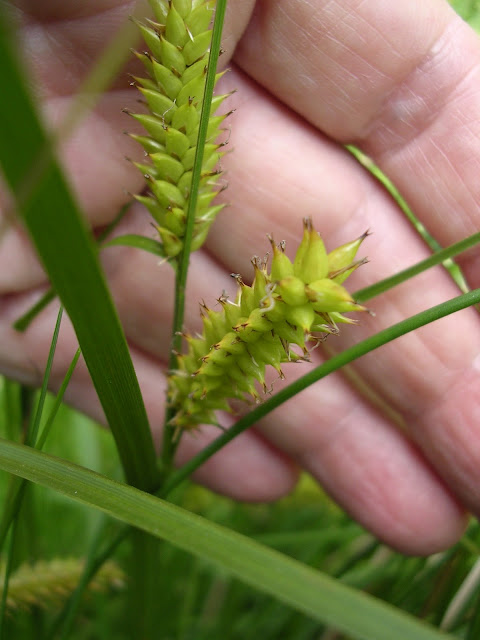Day 2 of the Grasses and Sedges course at Blencathra Field Centre - and the journey home. Notes on the drought
The BBC forecast - on the laptop- was fine for the Sunday morning: a big yellow sun - but for the afternoon: rain - torrential.
Our mission in the morning was to visit the south end of Lake Derwent - a flat area marshy area with good sedges and a wetter area kept with no grazing and fen plants. We hoped to find wetland sedges such as Bottle Sedge (Carex rostrata) Common Sedge (Carex nigra) Carnation Sedge (Carex panicea), and Bladder Sedge (Carex vesicaria) and others. Last year we had found Tufted sedge Carex elata.
 |
| Field Centre Minibus |
Thank you to local participant, Belinda, who sat in the front seat holding the map showing potential parking places. The place where I had parked last year had had a height restriction bar added just weeks earlier, so we would have to find somewhere else. The map had a list of parking places but these seemed rather rather too far away.
Belinda suggested asking at one of the hotels - they will let cars park for £5-00, and to my great relief we were allowed to do this.
With help from two students I pulled in as close to the wall as possible, whilst the other students crossed the road to the field.
We walked to catch up with the other students - but had to stop to help a toad cross the road... Wish I had a photo.
The slopes of the Borrowdale mountains rose steeply on either side, but we were in a wide flat bottomed valley, the head end of the glacial lake. We walked though a grassy pasture field with Crested Dog's-tail (Cynosurus cristatus), its long narrow green heads on narrow wiry stalks, held up above the level of the closely grazed grass. Other species grew in a ditch.
In the next field was clothed in a golden rushy/sedgy type plant covering huge areas. What was it? It turned out to be common Soft Rush - looking oh, so different, because the drought during May and June had turned it golden yellow.
We found Oval Sedge (Carex leporina - formerly C ovalis) - growing in dark shiny bright green tufts in the shape of an oval, all the shoots radiating out as if a boot had been placed in the centre. I demonstrated with my own boot. Sharp-flowered Rush (Juncus acutiflorus ) and Common Sedge (Carex nigra) were growing nearby. I ignored the Marsh Foxtail and Velvet Bent - both grasses - or we would never get to our destination.
The third field, now beside the river leading to the bridge, had lots of sedge swamp. I did not take the whole group into the swamp, not wanting to trample it, or for them to get their feet wet. We collected some Bladder Sedge Carex vesicaria - from the edge.
I like Bladder Sedge. I have only once found it near Settle and that was many years ago. It has big utricles - golden green when fresh, and the young leaves are yellow green. The base of the shoot is crimson/purple red and it is supposed to have fibrillae (though we found difficulty seeing any) these three pictures are from elsewhere -from Semerwater and Fewston
I like Bladder Sedge. I have only once found it near Settle and that was many years ago. It has big utricles - golden green when fresh, and the young leaves are yellow green. The base of the shoot is crimson/purple red and it is supposed to have fibrillae (though we found difficulty seeing any) these three pictures are from elsewhere -from Semerwater and Fewston
 |
| Carex vesicaria at Semerwater |
 |
| Carex vesicaria at Fewston Reservoir - See the long ligule |
 |
| Carex vesicaria at Fewston Reservoir - See the fibrillae |
We had lunch sitting in a long line on the river bank. - our feet suspended above the dry gravel shingle. Normally there would have been flowing water here. I remember it being filled with New Zealand Pigmy weed once. There was still water in the central part of the river bed, supplied by the hills of Borrowdale.
Lichens!.
I was impressed and intrigued. Someone interested in Lichens!!
I told him how the British Lichen Society had visited that shore line - I said two years ago - but now I realise it was 2018 - five years ago. I now wonder if our lichen leader had given him a list of what we had found. Small world.
It was now 12.15 and remember, rain was forecast in the afternoon. We explored over the footbridge into what I call the "Nature Reserve" - an area of board walk through ungrazed fen.
It was now 12.15 and remember, rain was forecast in the afternoon. We explored over the footbridge into what I call the "Nature Reserve" - an area of board walk through ungrazed fen.
From the boards the whole area looked tussocky - tussocks of Purple Moor-grass and Meadowsweet with scattered blue Devil's-bit Scabious.
Then we saw a couple of much larger tussocks: Tussocks of the Carex elata -- Tufted Sedge that I had noted last year (See good blogpost on this). This is one of only four really big tussocky sedges in Britain.
(The others being Carex paniculata, Carex appropinquata, and a variant of Carex nigra)
Our wellington booted participant nobly got off the board walk to look at some plants - Would she sink in the water / wet ground?
Then we saw a couple of much larger tussocks: Tussocks of the Carex elata -- Tufted Sedge that I had noted last year (See good blogpost on this). This is one of only four really big tussocky sedges in Britain.
(The others being Carex paniculata, Carex appropinquata, and a variant of Carex nigra)
Our wellington booted participant nobly got off the board walk to look at some plants - Would she sink in the water / wet ground?
No - the area was totally dry!! -the drought!
At the end of the fen boardwalk was a gate. Through this gate was a large pool - almost dried up - with even bigger tussocks of Carex elata. In the mud at the end of the pool was lots of the invasive plant New Zealand Pigmy-weed (Crassula helmsii) and tiny plants of Toad Rush (Juncus bufonius)- growing vigorously now that we had had rain last week. And some Marsh Spike-rush (Eleocharis palustris).
At the end of the fen boardwalk was a gate. Through this gate was a large pool - almost dried up - with even bigger tussocks of Carex elata. In the mud at the end of the pool was lots of the invasive plant New Zealand Pigmy-weed (Crassula helmsii) and tiny plants of Toad Rush (Juncus bufonius)- growing vigorously now that we had had rain last week. And some Marsh Spike-rush (Eleocharis palustris).
 |
| Carex elata |
 |
| Carex elata |
A few spots of rain.. So we set off on our walk back. And returned to the minibus by1.30m just as the heavens opened
Back in the lab we then spent a pleasant afternoon looking at specimens using keys and microscopes - with the door open to the warm air and rain pouring - rattling down outside.
----------------------------------------------------------
At 4.30 the students departed. - I had managed to finish a little bit early - that kept us all happy.
I had time to pop into the flowers group next door that had been running the same weekend, and meet the tutor and her daughter. Kathryn was helping tidy up.
I thanked her for bringing the new foraging book for her students.. which included a recipe for making "Sweet Vernal-grass Vodka"
.. though some health warnings included.. A useful (?less?) fact I can pass on to future students.
------------------------------------
I continued tidying and my mobile phone said 7pm when I finally left the centre.
------------------------------------
I continued tidying and my mobile phone said 7pm when I finally left the centre.


No comments:
Post a Comment